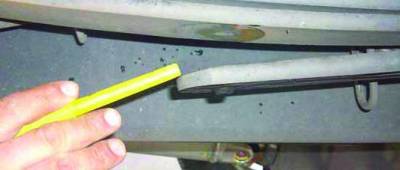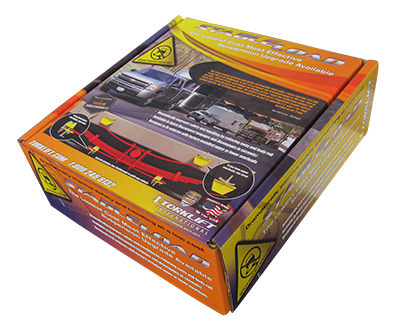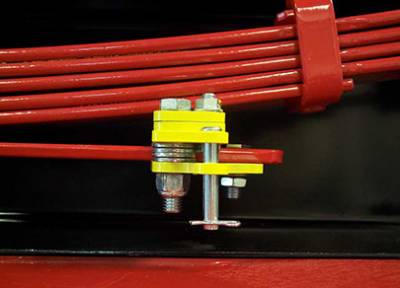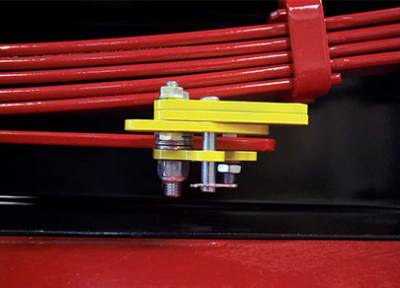The easiest way to understand how an overload leaf spring works is to think about it as if it were a muscle.
The yellow pencil above is pointing to your factory lower overload leaf springs. The majority of trucks, SUVs and vans have the lower and the upper overload leaf springs installed at the factory by the vehicle manufacturer. For the sake of simplicity, we will just talk about the lower overload leaf spring seen above.
The overload leaf spring AKA “the muscle,” is designed to help the vehicle when it becomes weighed down while towing or hauling something heavy such as a truck camper or a trailer.
How does the overload leaf spring “muscle” help?
When the vehicle, like a truck, is loaded down with a heavy weight, the rear begins to sag slightly. As the rear begins to sag it forces the lower overload leaf spring to come into contact with the other leaf springs above it.
Once the truck sags enough, most often several inches, the overload leaf springs begin to touch, and this begins to put the muscle into action.
It takes a sizeable weight to force them to come into contact on their own. Often times they don’t come into contact while the truck is towing or hauling leading to some massive negative side effects.
The negative side effects include side-to-side sway, body roll, poor handling, increased stopping distance, misaligned steering, increased tire wear and lack of control of the vehicle. Not only that, but now you are dealing with sag.
This is where the StableLoad suspension stabilizer comes in.
The StableLoad bolts onto the lower overload leaf spring.
The precision laser crafted StableLoads fit between the leaf spring overload gap to take up that empty space so the muscle is allowed to work immediately and to its maximum capability when towing or hauling. This results in dramatically improved handling characteristics and greatly reduces side-to-side sway, body roll and alleviates sag.
And even better, when you are not towing or hauling, the StableLoad is disengaged by simply rotating it away from the overload leaf spring while remaining bolted on when not in use. Doing so allows you to return to your factory ride when you are not towing or hauling.
Why do I want to have my StableLoads disengaged when I am not towing or hauling?
Disengaging the StableLoad allows for the gap between the overload leaf springs to return so you have a comfortable ride. The only time you want to have your StableLoads engaged is when you are towing and hauling. That gap between the overload leaf springs must be filled while towing and hauling to prevent poor handling, side-to-side sway, body roll and sag.
What is a common misconception about the overload leaf spring?
It is a common misconception that adding suspension upgrades to your vehicle will increase your vehicle’s factory towing or hauling capacity. The truth is, no towing, hauling or suspension upgrade can increase your factory towing/hauling maximum capacity ratings.
To ensure you are towing or hauling safely, have your vehicle inspected by a reputable towing or hauling equipment installation professional. If needed, upgrade your towing, hauling and suspension equipment to match the appropriate tongue weight and tow or hauling rating. Make sure it falls within your vehicle manufacturer’s tow ratings.
